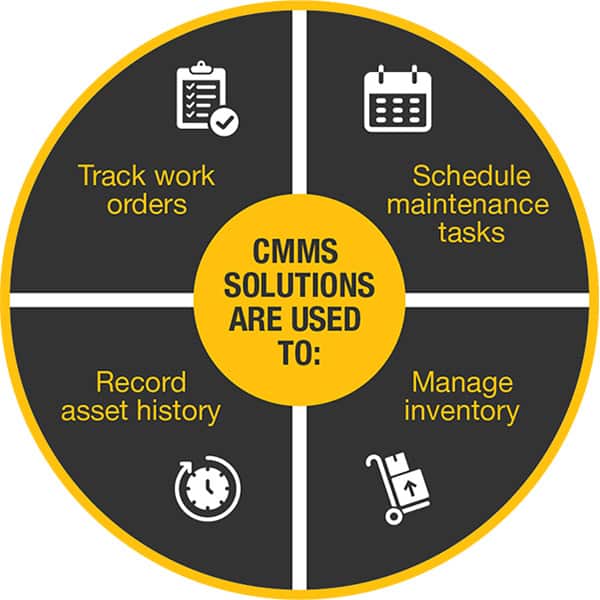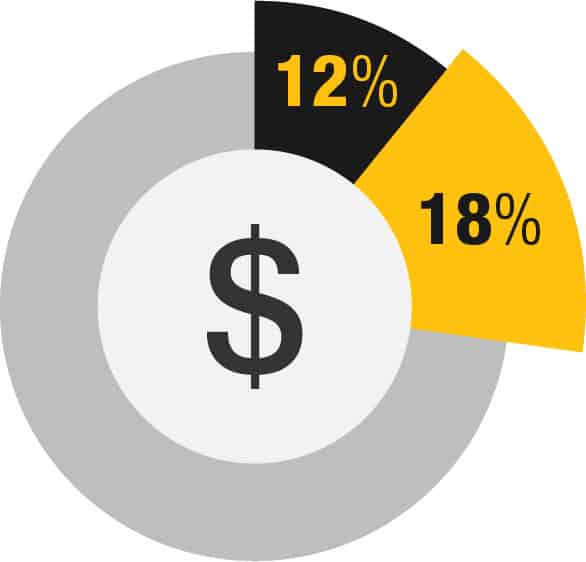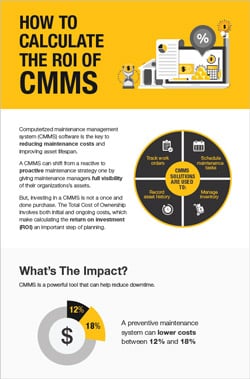What are CMMS solutions used for?
Computerized maintenance management system (CMMS) software is the key to reducing maintenance costs and improving asset lifespan. A CMMS can shift from a reactive to proactive maintenance strategy one by giving maintenance managers full visibility of their organizations’s assets. But, investing in a CMMS is not a once and done purchase. The Total Cost of Ownership involves both initial and ongoing costs, which make calculating the return on investment (ROI) an important step of planning.

What is the impact of implementing a CMMS?
A preventive maintenance system can lower costs between 12% and 18%.

Questions to answer before calculating CMMS ROI
- What’s your planned maintenance to corrective maintenance ratio?
- What information does your supervisor consistently request?
- What data/reports would make the job easier?
- What’s most of your maintenance budget being spent on?
- What’s your desired plan to corrective maintenance ratio?
How to calculate CMMS ROI?
Here is the equation to calculate the ROI of your CMMS.

What are the metrics needed to determine to value of a CMMS?
- Asset lifespan:
Estimate the number of years you expect to extend an asset’s lifecycle with preventive maintenance tasks and compare to asset purchase price. A CMMS generates and schedules preventive maintenance tasks that reduce system failure and downtime. - Overtime:
Calculate the average amount of hourly labor, including overtime wasted due to ineffective work order management. CMMS software gives you the ability to forecast labor hours more effectively, helping to reduce unexpected breakdown and employee overtime. - Inventory:
Estimate the amount of time lost to insufficient inventory and emergency purchasing. A CMMS can keep your company from being over- or under-stocked with a certain part or product. - Downtime:
Determine how much time is wasted from unscheduled asset downtime. A CMMS can automatically schedule preventive maintenance tasks, reducing asset downtime that directly impacts your revenue. - Utilities:
Find the total amount your organization spends on utilities each year and compare to the expected cost of utilities if assets and HVAC units were operating at peak efficiency. Regularly scheduled preventive maintenance techniques allow HVAC equipment to operate at maximum efficiency, which uses 15% to 20% less resources, like gas, electricity, and water. - Productivity:
Determine the amount of time spent on tasks, such as work order generation and scheduling. CMMS software can automate time-consuming activities, allowing maintenance managers to focus on more important duties. - Document management:
Determine how long it takes to create, file, copy, search for, and retrieve documents. 80% of employees waste an average of half an hour a day retrieving information. A CMMS stores all documents associated with an asset and maintains all historical records in a central location for easy access.
What is included in the total cost of ownership of a CMMS?
- Initial software
- Necessary hardware
- Implementation cost
- User training
- Support and upgrade
- License renewals


